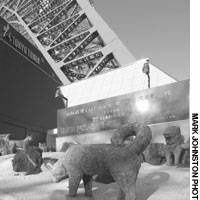Dear Alice,
Please do me a personal favor and go to Tokyo Tower and find out the story behind that pack of dog statues at the entrance. I know what you're thinking: "A pack of dog statues? She must mean a statue of a pack of dogs." Go and you'll see what I mean. There's a pebble garden with maybe a dozen statues of dogs in random poses. I can't read the sign and I'm dying to know what the heck it's all about.
Pushba L., Tokyo
I went and you're right -- it is a pack of dog statues. The Japan Society for the Prevention of Cruelty to Animals (Nihon Dobutsu Aigo Kyokai) erected the statues in 1959 to commemorate one of the most famous Japanese dog stories I'd never heard of until I got your inquiry. I'm really glad you asked because I learned a lot in the process of getting you an answer.
In 1958, a Japanese research expedition in Antarctica had to make an emergency evacuation and was forced to leave behind 13 sled dogs. Thinking that a relief team would arrive within a few days, they left the dogs chained up outside with a small supply of food. But the weather turned so bad that the boat with the next team had to give up and head back to Japan.
Naturally, everyone felt awful about the way the dogs had been left, with absolutely no chance for survival. But nearly a year later, when a new expedition arrived, they discovered two of the dogs alive and well. Taro and Jiro were instant heroes.
I had to wipe away tears as I read the story, but there was something gnawing at me. Just what did Taro and Jiro eat all those months? What if they'd been lunching on the other pooches in the mush line? After a bit more research I was relieved to learn that some of the dogs had slipped their collars and learned to hunt penguins and seals. Of the dogs that got free, only Taro and Jiro survived the dangers of the harsh climate, but there is nothing to suggest cannibalism. In fact, the frozen corpses of several dogs were found untouched. Heroes don't eat their buddies.
All of the dogs were Karafuto-ken (Sakhalin huskies), Karafuto being the Japanese name for Sakhalin Island and ken meaning dog. The breed spiked in popularity around 1983 , when director Koreyoshi Kurahara turned the story of Taro and Jiro into a hit movie called "Nankyoku Monogatari (Tale of Antarctica)." I rented it on DVD from my local video store and recommend it, both for the moving story and the amazing scenery of Antarctica. The English version, "Antarctica," doesn't seem to be distributed in Japan, but you can buy it online.
So what became of Taro and Jiro? Despite their hero status (there are statues in their honor in other cities too, including Nagoya and Wakkanai), they both stayed on to pull sleds for the new expedition. Taro returned to Sapporo and lived at Hokkaido University until his death in 1970, after which he was stuffed (hakusei -- now there's a useful vocabulary word) and put on display at the university's museum. Jiro died in Antarctica in 1960 of natural causes. You can pay him a visit at the National Science Museum in Ueno Park, Tokyo.


















With your current subscription plan you can comment on stories. However, before writing your first comment, please create a display name in the Profile section of your subscriber account page.